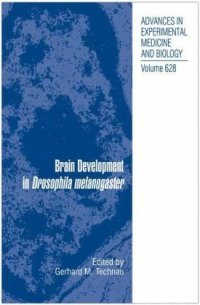
Ebook: Brain Development in Drosophila melanogaster
- Genre: Medicine
- Tags: Biomedicine general
- Series: Advances in Experimental Medicine and Biology 628
- Year: 2008
- Publisher: Springer-Verlag New York
- City: New York :, Austin, Tex
- Edition: 1
- Language: English
- pdf
The central nervous system (CNS) represents the organ with the highest structural and functional complexity. Accordingly, uncovering the mechanisms leading to cell diversity, patterning and connectivity in the CNS is one of the major challenges in developmental biology. The developing CNS of the fruitfly Drosophila melanogaster is an ideal model system to study these processes. Several principle questions regarding neurogenesis (like stem cell formation, cell fate specification, axonal pathfinding) have been addressed in Drosophila by focusing on the relatively simply structured truncal parts of the nervous system. However, information processing (e.g., vision, olfaction), behavior, learning and memory require highly specialized structures, which are located in the brain. Owing to much higher complexity and hidden segmental organisation our understanding of brain development is still quite rudimentary. Considerable advances have been made recently in bringing the resolution of brain structures to the level of individual cells and their lineages, which significantly facilitates investigations into the mechanisms controlling brain development. This book provides an overview of some major facets of recent research on Drosophila brain development.